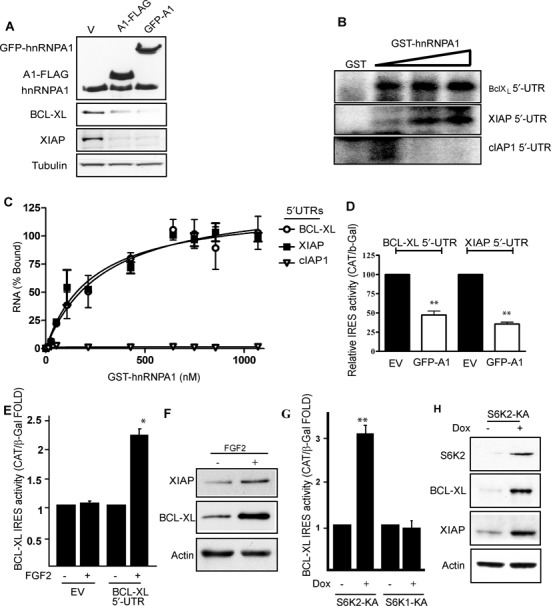Figure 2.

hnRNPA1 binds to BCL-XL, XIAP transcripts in vitro and regulates their translation. (A) N-term GFP- and C-term FLAG-tagged hnRNPA1 were transiently expressed in HEK293 cells and western blotting (WB) performed for the indicated proteins 72 h later. (B and C) Recombinant GST-hnRNP A1 was incubated in the presence of 32P-labelled, in vitro transcribed BCL-XL, XIAP or cIAP1 (negative control) 5′-UTR RNAs and UV crosslinked. (B) RNA–protein complexes were analysed by SDS-PAGE/autoradiography. GST was used as a negative control. (C) Increasing concentrations of GST-hnRNPA1 were used to bind the UTRs and the signal from nitrocellulose filter binding assays quantified by beta counter. (D, E and G) Bicistronic DNA constructs containing XIAP or BCL-XL IRES elements were co-transfected into (D) HEK293 cells along with GFP (EV) or GFP-hnRNPA1 (GFP-A1) expressing plasmids, (E) transfected into HEK293 cells treated ± FGF-2 for 4 h or (G) into HEK293 cells stably expressing tetracycline-inducible kinase-active (KA) S6K1 or 2 treated overnight ± doxycline (Dox). IRES activity was measured as ratio of CAT to β-gal expression. (F and H) HEK293 cells (F) or S6K2-KA HEK293 cells (H) were stimulated ± FGF-2 for 4 h or overnight ± Dox, respectively, and samples analysed by WB for the indicated proteins. (C, D, E and G) Results are the average of triplicates ± SEM. Student's t-test: *P < 0.05; **P < 0.01.
